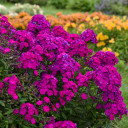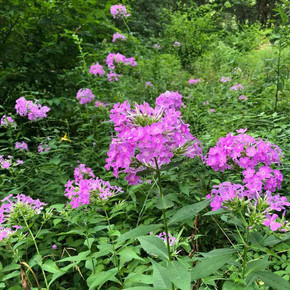
Phlox paniculata 'Ultraviolet'- GARDEN PHLOX 'ULTRAVIOLET' (TALL PHLOX)
"Improved" version of Phlox paniculata ‘Nicky' - with darker stems and buds, bronzed leaves, more floriferous performance, and better resistance to powdery mildew.
Blooming Time: mid to late summer, with some reblooming later on
Size: 32-36" tall x 28-32" wide, spacing 1.5’
USDA Zones: 3 to 8
Culture: Can be planted in full sun, half sun or light shade. Grows well in average soil, prefers good soil enriched with compost or other organic material and occasional fertilizing. Prefers loamy, rich soils with enough moisture. Planting in a place with good air circulation is recommended to prevent mildew.
Moisture Needs: medium (average) to medium moist
Origin: Introduced by Walters Gardens (Zeeland, MI), part of LUMINARY® Collection and Proven Winner. Patented plants under PP33607. See the distribution of the wild species of Phlox paniculata on the map of USDA.
Black Walnut Tolerant: yes
Deer/Rabbit Resistant: no / no, some protection needed (deer and rabbit repellent, fence)
Attracts Butterflies or Pollinators: some butterflies, some bees
Attracts Hummingbirds: yes
Pot Size: round Proven Winner quart (4.23" x 5" tall)
Plant Combinations: Best in flower beds, both private and public landscaping projects, cottage gardens, hummingbird and butterfly gardens or some naturalization.
Good companion perennials can be: Agastache (tall blue or bluish flowering, Agastache ‘Black Adder‘ ), lower varieties of Coreopsis tripteris, Echinacea, Eupatorium, Filipendula rubra ‘Venusta‘, Helenium, Monarda, other varieties of Phlox paniculata, Rudbeckia, Veronicastrum or cultivars of grass Muhlenbergia, Panicum virgatum, and Sporobolus.
Good non-native perennial combinations include Astilbe chinensis (taller varieties), Astrantia major, Delphinium, Geranium, Geum x hybridum, Hemerocallis, Leucanthemum superbum, Lilium, Persicaria amplexicaulis, Sanguisorba, Scabiosa caucasica or Thalictrum.
Very charming in combination with nativars of the native shrub – Hydrangea arborescens or non-native Hydrangea paniculata or some roses in the background.
Picture Copyright: Walters Gardens

Phlox paniculata 'Ultraviolet'- GARDEN PHLOX 'ULTRAVIOLET' (TALL PHLOX)
"Improved" version of Phlox paniculata ‘Nicky' - with darker stems and buds, bronzed leaves, more floriferous performance, and better resistance to powdery mildew.
Blooming Time: mid to late summer, with some reblooming later on
Size: 32-36" tall x 28-32" wide, spacing 1.5’
USDA Zones: 3 to 8
Culture: Can be planted in full sun, half sun or light shade. Grows well in average soil, prefers good soil enriched with compost or other organic material and occasional fertilizing. Prefers loamy, rich soils with enough moisture. Planting in a place with good air circulation is recommended to prevent mildew.
Moisture Needs: medium (average) to medium moist
Origin: Introduced by Walters Gardens (Zeeland, MI), part of LUMINARY® Collection and Proven Winner. Patented plants under PP33607. See the distribution of the wild species of Phlox paniculata on the map of USDA.
Black Walnut Tolerant: yes
Deer/Rabbit Resistant: no / no, some protection needed (deer and rabbit repellent, fence)
Attracts Butterflies or Pollinators: some butterflies, some bees
Attracts Hummingbirds: yes
Pot Size: round Proven Winner quart (4.23" x 5" tall)
Plant Combinations: Best in flower beds, both private and public landscaping projects, cottage gardens, hummingbird and butterfly gardens or some naturalization.
Good companion perennials can be: Agastache (tall blue or bluish flowering, Agastache ‘Black Adder‘ ), lower varieties of Coreopsis tripteris, Echinacea, Eupatorium, Filipendula rubra ‘Venusta‘, Helenium, Monarda, other varieties of Phlox paniculata, Rudbeckia, Veronicastrum or cultivars of grass Muhlenbergia, Panicum virgatum, and Sporobolus.
Good non-native perennial combinations include Astilbe chinensis (taller varieties), Astrantia major, Delphinium, Geranium, Geum x hybridum, Hemerocallis, Leucanthemum superbum, Lilium, Persicaria amplexicaulis, Sanguisorba, Scabiosa caucasica or Thalictrum.
Very charming in combination with nativars of the native shrub – Hydrangea arborescens or non-native Hydrangea paniculata or some roses in the background.
Picture Copyright: Walters Gardens










